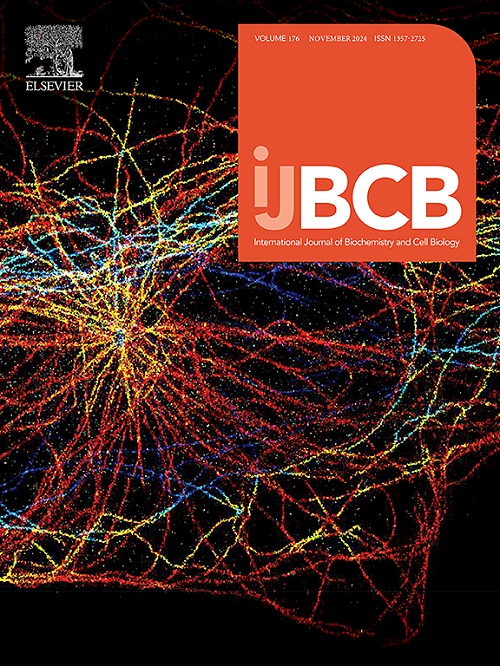Aminoadipic acid aggravates atherosclerotic vascular inflammation through ROS/TXNIP/NLRP3 pathway, a harmful microbial metabolite reduced by paeonol
IF 3.4
3区 生物学
Q2 BIOCHEMISTRY & MOLECULAR BIOLOGY
International Journal of Biochemistry & Cell Biology
Pub Date : 2024-10-26
DOI:10.1016/j.biocel.2024.106678
引用次数: 0
Abstract
Aim
Our previous study has found a differential microbial metabolite in atherosclerosis (AS) mice, aminoadipic acid (AAA), which was considered as a potential harmful metabolite. However, whether it can promote AS vascular inflammation and its mechanisms remain unclear. Paeonol (Pae) plays an anti-AS role by regulating the metabolic profile, but whether Pae exerts its antiatherogenic effect by reducing serum AAA levels is unknown.
Results
The clinical trial results showed that the AS patients’ serum AAA levels were higher than those healthy people’. Besides, AAA supplementation could increase aortic plaque size, serum inflammatory cytokines levels and liver malondialdehyde, superoxide dismutase levels in AS mice. Moreover, after AAA stimulation, the ROS levels and ASC, TXNIP, NLRP3 and caspase-1 proteins levels were increased in HUVECs, which could be reversed by antioxidant NAC and NLRP3 inhibitor. Pae significantly reduced the plaque size in the aorta, improved blood lipid levels and decreased serum inflammation factor levels in AS mice. Simultaneously, Pae could reduce the serum AAA levels of AS mice through the gut microbiota transmission. Finally, Pae inhibited NLRP3 inflammasome activation in aortas of AS mice. Broad-spectrum antibiotics could weaken the inhibitory effect of Pae on NLRP3 inflammasome.
Conclusion
Our study clarified that AAA could promote AS vascular inflammation via activating the ROS/TXNIP/NLRP3 pathway. Pae could inhibit AS development by reducing serum AAA levels in a microbiota-dependent manner. Taken together, we proposed that AAA could be served as a potential biomarker for AS clinical diagnosis and provided a new treatment strategy for AS.
氨基己二酸通过 ROS/TXNIP/NLRP3 通路加重动脉粥样硬化性血管炎症,芍药酚可减少有害微生物代谢物的产生
目的我们之前的研究在动脉粥样硬化(AS)小鼠体内发现了一种不同的微生物代谢物--氨基己二酸(AAA),它被认为是一种潜在的有害代谢物。然而,它是否能促进动脉粥样硬化血管炎症及其机制仍不清楚。芍药酚(Pae)通过调节代谢轮廓发挥抗强直性脊柱炎的作用,但芍药酚是否通过降低血清 AAA 水平来发挥抗动脉粥样硬化的作用尚不清楚。此外,补充 AAA 可增加 AS 小鼠主动脉斑块的大小、血清炎性细胞因子水平和肝脏丙二醛、超氧化物歧化酶水平。此外,AAA刺激后,HUVECs中ROS水平、ASC、TXNIP、NLRP3和caspase-1蛋白水平均升高,而抗氧化剂NAC和NLRP3抑制剂可逆转这一现象。Pae能明显缩小AS小鼠主动脉斑块的大小,改善血脂水平,降低血清炎症因子水平。同时,Pae 还能通过肠道微生物群传递降低 AS 小鼠血清 AAA 水平。最后,Pae能抑制AS小鼠主动脉中NLRP3炎性体的激活。结论我们的研究阐明了AAA可通过激活ROS/TXNIP/NLRP3途径促进AS血管炎症。Pae可通过降低血清中的AAA水平,以微生物群依赖的方式抑制强直性脊柱炎的发展。综上所述,我们认为AAA可作为强直性脊柱炎临床诊断的潜在生物标志物,并为强直性脊柱炎提供了一种新的治疗策略。
本文章由计算机程序翻译,如有差异,请以英文原文为准。
求助全文
约1分钟内获得全文
求助全文
来源期刊
CiteScore
8.10
自引率
0.00%
发文量
124
审稿时长
19 days
期刊介绍:
IJBCB publishes original research articles, invited reviews and in-focus articles in all areas of cell and molecular biology and biomedical research.
Topics of interest include, but are not limited to:
-Mechanistic studies of cells, cell organelles, sub-cellular molecular pathways and metabolism
-Novel insights into disease pathogenesis
-Nanotechnology with implication to biological and medical processes
-Genomics and bioinformatics

 求助内容:
求助内容: 应助结果提醒方式:
应助结果提醒方式:


